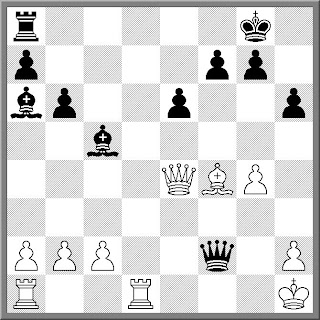

The position in the first diagram arose in the game V. Ciocaltea – L. Christiansen, Torremolinos 1976 after Black's 15th move. White decided it was time for an unwarranted attack, and came up with the aggressive-looking:
16.g4?!
Black can safely ignore this pawn advance with 16...Bb7 17.g5 hxg5 18.Bxg5 Rfd8, when it looks like all White has done is weaken his position. But Christiansen has a somewhat different idea.
16...Nd7!?
At first this too looks fishy. Why not 17.Qe4 threatening mate and the rook? Of course Christiansen had seen all this, and he wrote that 17...f5 18.Qxa8 Nxe5 would give Black a “crushing counterattack.” That is certainly true, but White can do better with 18.gxf5 exf5 19.Qd5+ Kh7 20.Nc4 Qh4 21.Be3, which could be just equal.
More critical for Black's idea is 17.Be4 Nxe5 18.Bxa8. Christiansen gave 18...Qh4 19.Bf4 Ba6 20.Qxe5 Qxf2+ 21.Kh1 Rxa8 22.Qe4 (second diagram) and now “22...Be2! 23.Qxa8+ Kh7 24.Rd3 Qxf4, when Black's raging bishops rule the board.”
Here is the real mystery. Well, two mysteries actually. Black's bishops can do all the ruling they want, but if all they can do is win back the double exchange, then it doesn't add up to much. Try to find a win for Black after 24...Qxf4 25.Qg2! I don't think it's there.
The second mystery – and the true subject of today's article – is why on earth Black should give up his rook with check. After 22.Qe4 he should forget about abstract ideas of ruling the board and instead play the simple 22...Rc8! The threat is Bb5-c6 with disaster on the long diagonal. White can grovel, but in the long run Black must prevail.
For the record, the game continuation was:
17.g5 Nxe5 18.Qxe5 f6 19.Qe4 f5 20.Qh4 Bb7 21.Qh5 Qc7 22.Bb5 Rad8 23.Rxd8 Rxd8 24.gxh6 Qe5 25.Qg5 Qe1+ 0–1


